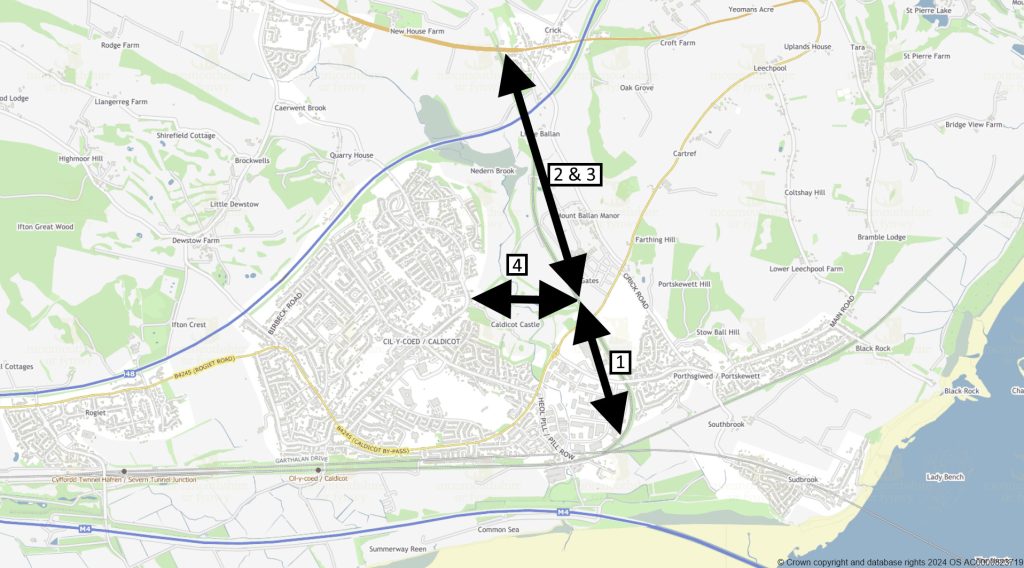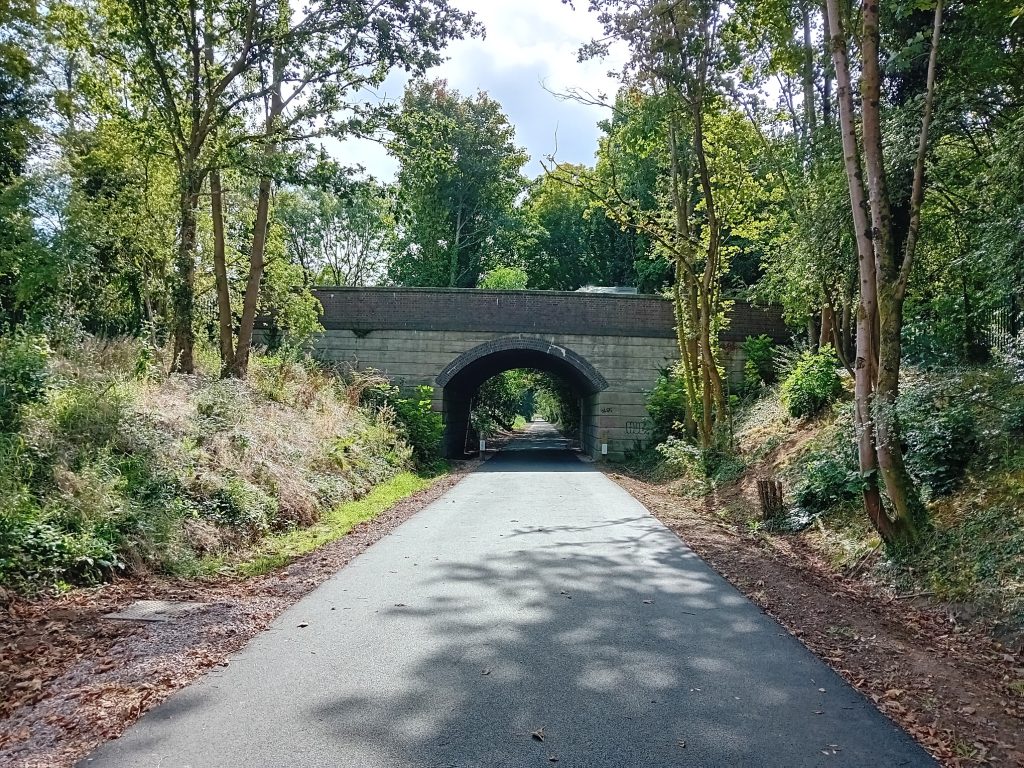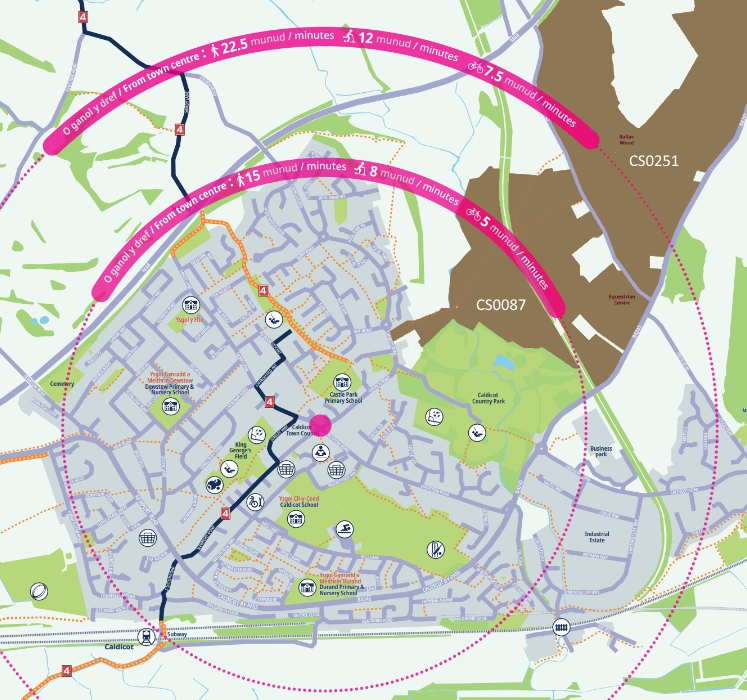Caldicot Active Travel Links and Multi-User Route – Q&A
The Caldicot Links active travel scheme is designed to create an integrated network of shared use routes, linking existing and planned residential areas around east Caldicot to local destinations and public transport. The aim is to enable residents to use active travel for local trips and to connect to the wider Severnside active travel and public transport networks, through the construction of high quality and accessible routes for walking, wheeling and cycling.
Caldicot Active Travel Links scheme
Caldicot Links scheme focuses on the north and east of Caldicot. The scheme is broken down in to three different sections* (see plan below):
- Phase 1: Running along the route of the old ex-Ministry of Defence Dinham railway line, from just south of the Cornfield at Portskewett, to level with Caldicot Castle Country Park.
- Phases 2 & 3: From level with the country park northwards to Crick, crossing the northeast Caldicot RLDP sites.
- Phase 4 – Multi User Route: Running through Caldicot Castle Country Park connecting up with the Caldicot Links and the B4245 at its eastern end and linking into Church Road (and on to Caldicot Town Centre) at its western end.
*Sections of the scheme are being brought forward as funding and other constraints permit, i.e. not necessarily in numerical order.

Current progress
Phase 1: Main construction work is now completed, with some minor works still to be completed in autumn 2024 which include: tree planting, landscaping, lighting and signage.
You are welcome to use this section of the new Caldicot Links active travel route for walking, wheeling, and cycling. Please note that this route is not being promoted as accessible to all users at this time and represents the first stage in delivering a complete connection from Portskewett to Caldicot.
Please note the following:
- Caldicot Castle Country Park: There is currently no formal hard-surfaced path connecting this tarmac path to the Country Park tarmac service road. Users wishing to continue into the Country Park will need to use informal grass paths, which have uneven surfaces, slopes, and gates.
- Elderwood Parc: There is no onward connection from the top of the ramp into Elderwood Parc due to the housing development still being under construction.


Picture: Caldicot Links phase 1, before and after.
Phases 2 & 3: MCC appointed consultants have undertaken a study of the options available for developing the route north and east of the Country Park, considering the key opportunities and the constraints of this area. MCC is now progressing the next steps with developing this section.
Phase 4 – Multi User Route: Consultants are being appointed to progress the design and permission work up to pre-construction stage for a proposed new active travel route running from the northern end of the Links Phase 1 through the eastern side of Caldicot Castle Country Park to join the existing country park tarmac road just east of the Nedern brook. Additional separate assessment work is being undertaken to look at the onward connections to both the east and west.
Why focus on north and east Caldicot?
This scheme looks to improve sustainable access to services, shops, and sites of education and employment around Caldicot. Trip generation related to the planned residential development to the east and north of Caldicot, as well as the need to mitigate congestion related to local employment sites and the newly toll-free Severn bridges gives extra impetus to the scheme, as this is an opportunity to make active travel the preferred mode for local trips for old and new residents alike.
The phased Caldicot Links scheme focuses on the east of Caldicot, including linking to housing developments off Church Road and Crick Road, to ensure that current and future residents have accessible, healthy and sustainable transport options, to minimise and manage the road traffic impact of a growing population and to direct residents and visitors into the town centre as a local destination.
Below is a detail of our Active Travel Map for Caldicot, showing the time it would typically take to travel in the local area. The local development areas, shown in brown, will include parcels of green space (i.e. the indicated sites include areas that will not be built up):

What is active travel?
Active travel is a term used to describe walking, wheeling or cycling to a destination, which the Active Travel Act (Wales) 2013 calls “purposeful journeys”. It does not cover trips taken purely for leisure although it could significantly enhance leisure activities by helping to link up networks. Active travel can be used to get to school, work, services and shops, or as one of several modes on a longer journey – for example, walking to the station to catch a bus or train. Monmouthshire County Council (MCC)’s active travel strategy focuses on journeys of three miles or less, which means improving walking and cycling infrastructure within communities and between close-by settlements such as Caldicot, Portskewett and Crick, so that active travel can be the natural choice for local journeys. MCC also aims to improve active travel links to public transport, to support sustainable travel across the county.
How is the Caldicot Links scheme funded?
The Caldicot Active Travel links and Multi-user route will be funded through Welsh Government grants aimed at improvements to sustainable transport modes.
How will the removal of trees along active travel path route be mitigated?
In the construction of Links Phase 1, trees and vegetation have been cleared to make way for the path and its access ramps. Additional tree clearance was also required in response to ash dieback being present on site and was combined to be more cost effective. The amount of clearance was only that which was required to ensure the old railway line is safe for current users and to enable the construction of the Active Travel route while safeguarding wildlife on site. Once construction is complete, compensation planting of native trees and shrubs will introduce a more varied and resilient tree canopy bringing a net benefit for local biodiversity after the intervention.
The improved active travel routes are expected to increase local walking, wheeling and cycling opportunities, which should have a long-term positive impact on the environment and local biodiversity as described by Welsh Government’s Active Travel Act Guidance.
Contact us
If you would like to contact the project team, please email ActiveTravel@monmouthshire.go
This post is also available in: Welsh
